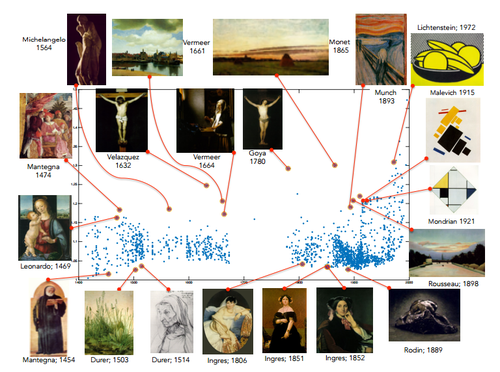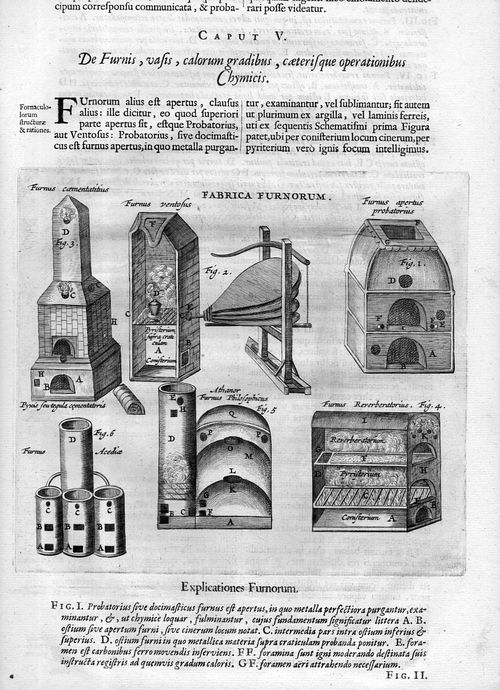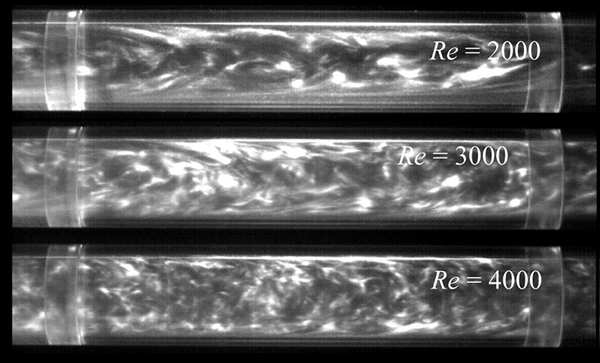This article was published in Scientific American’s former blog network and reflects the views of the author, not necessarily those of Scientific American
To Predict Turbulence, Just Count the Puffs. These tiny swirls of fluid live, die, reproduce, and spark turbulence. "Turbulence emerges when the birth rate of puffs exceeds the death rate, and the puffs are able to colonize the fluid."
Black Hole Hunters and their Event Horizon Telescope: Aiming to make the first portrait of the hungry monster at the center of our galaxy, astronomers built ‘a telescope as big as the world' -- a network of antennas that reaches from Spain to Hawaii to Chile.
The Universe as a Fruitcake: Why is the universe so big and uniform? David Kaplan describes the leading cosmological explanation.
On supporting science journalism
If you're enjoying this article, consider supporting our award-winning journalism by subscribing. By purchasing a subscription you are helping to ensure the future of impactful stories about the discoveries and ideas shaping our world today.
How Science Helps Golfers Drain Those Tricky Putts. Tips from physics, physiology, and maybe even music can help you improve your score.
Stanford Built a New Kind of Computer That Uses Water Drops.
Life Lessons from The Martian (it's not all about physics). "More than any other story I've read, this book emphasizes the need for a broad scientific literacy that lies deeper than a Google search (no internet on Mars), as a matter of life and death."
LEGO optics Lab: Build Your Own Beam-Splitter with a dichroic prism and a laser pointer.
Read about the physics of a theremin, or watch a cat play one? "Of course, you can choose to do both."
The Beauty of Uncertainty: How Heisenberg Invented Quantum Mechanics, Told in Jazz. Quantum mechanics and the combinatorial nature of creativity, set to song.
Wi-Fi Charging Works, But It Can’t Really Power Your Phone. "It’s not an engineering problem, it’s a physics problem." Damn you, inverse square law! Related: Wireless carriers sue to block cell phone radiation warning requirement
Every Satellite Got Into Space Thanks to Newton's Law of Gravitation. Related: The Life and Times of Isaac Newton's Apple Tree (historical infographic).
The Shifting Sands Of The Sahara Are A Lesson In Dune Dynamics. Related: Vivaldi’s Four SeasonsBrought to Life in Sand Animations by the Hungarian Artist Ferenc Cakó.
The Physics of Butterfly Flight. "First off, butterflies are totally the dancing queens of the animal world! They have amazing and unnecessarily huge wings for their tiny bodies. Their wings are way bigger than many other insects of the same weight. And new research shows butterflies don’t even need all of that wingspan - their wings are so massive they can fly even with half their wing cut off."
Who named the qubit? Ben Schumacher! Bonus: an original poem by Caltech's John Preskill."I was going for edgy but might have crossed the line into bizarre." Related: 20 years of qubits: the arXiv data.
Quantum vision. Researchers hope to show whether human eye can detect a single photon — and its superposition
Five Things We Still Don’t Know About Water. From steam to ice, water continues to mystify. Related: Richard Saykally answers a burning question: Why is water wet? “Strong tetrahedral hydrogen bonding.” Also: A Rare Look Inside The Formation Of A "Worthington Jet" Of Water.
The Road Less Traveled: an exclusive interview with Lee Smolin about the state of the field of quantum gravity. "While we’re all still waiting on quantum gravity both theoretically and experimentally, we’re also convinced that it must be real. It’s just a matter of getting there, which may prove to be either right around the corner or off at the far reaches of the great energy desert."
What is cosmological hysteresis? Authors of a new paper argue it would make cyclic cosmological models viable alternatives to inflation.
Philosophy of the Large Hadron Collider. There have been many tedious discussions about the value of philosophy for modern science. Michael Krämer finds it much more interesting to ask if and in what way modern science can advance philosophy.
A Crisis At the Edge of Physics: "Do physicists need empirical evidence to confirm their theories? You may think that the answer is an obvious yes, experimental confirmation being the very heart of science. But a growing controversy at the frontiers of physics and cosmology suggests that the situation is not so simple."
Does Quantum Gravity Need String Theory? If String Theory has nothing to do with reality, what are our options?
Physicists at the Large Hadron Collider are using LHC detector technology to retrieve Native American music from old recordings.
Engineers create origami paper-based bacteria-powered battery. "Origami, the Japanese art of paper folding, can be used to create beautiful birds, frogs and other small sculptures. Now a Binghamton University engineer says the technique can be applied to building batteries, too."
Neil deGrasse Tyson Says Hoverboards Are Still a Ways Off. Related: How far are we from Terminator's killing robots? DARPA has the answer.

Credit: Ahmed Elgammai and Babak Saleh, Rutgers University
Machine Vision Algorithm Chooses the Most Creative Paintings in History (above). Picking the most creative paintings is a network problem akin to finding super spreaders of disease. Obvious caveat: "most creative" is an inherently subjective quality.
An Electromagnetic Catapult For Hurling Planes Into The Air. That's one way to get a plane off a ship quickly.
A Quantum Of Parody: Boring Niels Bohr inspired the Journal of Jocular Physics.
This Unbelievable Coincidence Is Responsible For Life In The Universe. "The 'beryllium bottleneck' should have choked out all life before it even got started."
NASA’s ‘Flying Saucer’ Mars Lander Splashes Down in the Pacific, although the parachute failed to inflate in test flight to land larger vehicles on Mars. The space agency’s trials over Hawaii are meant to experiment with ways to send more sophisticated robots and eventually humans to red planet.
NASA orbiter spots glass on Mars, a first that could contain signs of long-ago life.
Meet the Woman Behind the Apollo Project: Margaret Hamilton's code made mankind's "giant leap" possible.
The Spacesuit Fire That NASA Refuses to Forget. The Extravehicular Mobility Unit (EMU) has been the suit worn by spacewalking astronauts since the beginning of the Space Shuttle Program. A mishap during development of the EMU helped to shape NASA’s current safety culture.
Could fast radio burst from pulsars be a window into new physics?
How to build a comet: Computer simulation sheds light on mysterious time in the Solar System's history.
Looking for Dark Matter Under A Mountain: the DarkSide-50 detector.
Flawlessly logical. Leonard Nimoy gets an asteroid named after him.
How to Make a Burning Candle Seesaw by lighting both sides while it’s balanced on a needle between two glasses.
A little number theory makes the multiplication table a thing of beauty.
Geometry fans: Naked Geometry offer this nifty Golden Radio LED Hanging lantern, curio bookshelves and more.
A Technique is Just a Trick That Went Viral. "Sometimes the general techniques fail, and you need a sneaky trick. That’s life." And that's math.
Teen Makes Graduation Dress Out of Math Homework To Raise Money for Malala Fund. "Erinne’s dress was made out of old calculus homework, black satin, and velvet, with the message 'I’ve received my education. Not every woman has that right' written on it in red ink."
Particle And Astro Aren't The Only Kinds Of Physics, according to Chad Orzel. And all this week, he's been reporting for Forbes from the annual meeting of the American Physical Society's Division of Atomic, Molecular and Optical Physics (DAMOP). First: Making And Shaking New Materials With Ultracold Atoms. Second: using atoms -- technically, the wave nature of matter -- to measure really tiny and possibly exotic forces.
Making tiny earthquakes to understand fracking-driven quakes. Experiment challenges our explanation for quakes from deep fluid injections.
A Scientist Responds... To Deep Impact. "Ahahahahahhahahahahahahaha hah ah aha ha ha ha... Wait, you’re serious?" Related: Yes, Jurassic Park's Bad Dinosaur Science Still Matters. Also: Sci-fi and Jurassic Parkhave driven research, scientists say. "As well as being the year that the film was released, 1993 also marked a turning point in the world of ancient DNA research: a team of researchers extracted and sequenced DNA from a 125-130m-year-old ancient weevil in Lebanese amber." Bonus: "I enjoyed the whole absurdity of it": Two Smithsonian paleontologists review Jurassic World.
How To Cut A Vortex Into Slices to solve some of the problems with mixing of liquid in micro channels.

Caption: Fabrica Furnorum, p. 239, in chapter "De Origine Alchymiae." Via Ptak Science Books.
Now you can own Images (engravings) from Athanasius Kircher's Mundus Subterraneus, 1668 (sample above). "Kircher... approaches the nature of terrestrial heat, volcanoes, the origins of lakes and rivers, optics, fossils/agates (in "de lapide philosopherum"), distillation, alchemy, ocean currents, insects, plant life, and so on, a real summa cum laude tour de force, Kircher being the Renaissance man's Renaissance man."
No One Knows What to Do With Fukushima’s Endless Tanks of Radioactive Water.
The Boy Who Built A 500-Million-Degree Nuclear Fusion Reactor (excerpt).
Someone Made a Really Powerful Homemade 40W Laser Shotgun.
Engineering research produces soft material with controllable surface textures that can be varied by squeezing.
These videos show the effect of gravity on slimy little men — specifically, toys called “Peta Peta men.”
No, Writing Intelligibly About Science Is Not 'Dumbing It Down,' it's using “shared language.”
This week on Virtually Speaking Science, I chatted with Brendan Nyhan regarding cognitive biases, phase transitions, and identity politics. You can listen here.
This week in Internet Drama: When Smart People Say Stupid Things. Biologist Tim Hunt, who won the 2001 Nobel Prize in medicine, was giving a talk at the World Conference of Science Journalists in South Korea when he expressed his support for sex-segregated labs and admitted he has a reputation as a chauvinist. His problem with female scientists: “You fall in love with them, they fall in love with you, and when you criticize them, they cry!” Per The Daily Beast: "Maybe lady scientists just can’t take a joke? Not so, tweeted prominent science writer Deborah Blum, who wrote that Hunt doubled down when she asked him about his comments. 'I was hoping he'd say it had been a joke. But he just elaborated. Sigh.' Blum tweeted. 'He did tell me that he thought I might hold up okay because I didn't seem the crying kind.'"
Naturally, this sparked an online outcry. The Guardian alone featuredseveral different commentaries and highlighted the unseen women scientists behind Hunt’s Nobel prize, while Dean Burnett went for humor, suggesting old white men should be banned from science. Maybe he's onto something, given a handful of studies (highlighted ironically by the folks at Improbable Research) on how “Interacting with Women Can Impair Men’s Cognitive Functioning.” The best thing that came out of the fracas: Female Scientists Mocked Nobel Laureate’s Remarks With a #DistractinglySexy Campaign on Twitter.
Hunt soon issued a typical non-apology, saying he was “really sorry,” and -- contrary to what he told Blum -- tried to play the ladeez-just-can't-take-a-joke card, insisting it was "intended is a light-hearted ironic comment" that was "interpreted deadly seriously by my audience." Okay, except he “did mean” his sexist remarks -- hey, he was just "trying to be honest." Mostly, he was sorry he said those things to a roomful of science journalists, many of whom were women. That apology played about as well as his original ill-advised remarks.
The Royal Society promptly distanced itself from Hunt's comments, and by Friday he had resigned his honorary position at University College London. The American Association for the Advancement of Science pulled Hunt from a planned webinar in which he was scheduled to offer advice on "persevering in science." The President of the European Research Council, in contrast, defended Hunt, saying "during the time I have worked with him on the ERC Scientific Council he has only ever been a supporter of gender balance." Sadly, Hunt is not alone in his bigotries. Slate highlighted a few of the most boneheaded, racist, and sexist comments from Nobel laureates. Even then, such blatant instances of bias are only the most publicized examples of a more pervasive problem.
Restoring a teensy bit of gender balance: Meet the world's hottest maths teacher Pietro Boselli: 'I model wet steam flow.' Male supermodel talks openly about his true passions: maths, the fluid dynamics of turbo machinery, and the number eight.
How Misperceptions About Math Contribute to the Gender Gap, according to a new study in Frontiers of Psychology. "Lead author Samantha Nix, a PhD student at Florida State University and lead author of the paper, said she had been interested in the way people talk about math and science. 'A very common thing that people say and that has been part of the scholarly literature is this whole concept of ‘I’m just not a math person,’” she said. “And that really may be blocking people from making the decision to enter these fields.'"
Chinese-American physicist pleads not guilty to technology theft.
Pantograph Imagines Gadgets From A Parallel World. "A tube amp wireless router? A binary code typewriter with only a zero and one? A record player that can play 4 records – vocals, guitar, base and drum – at the same time?"
"The story of technology is in fact the story of textiles."
Feynman to Wolfram: "You have to extract yourself from the organization in order to run it."
Five reasons we should celebrate Albert Einstein. From his radical thinking to his radical politics, his disavowal of celebrity to his wild hairstyle, the great physicist’s significance endures, argues his biographer Related: June 12, 1918: Einstein’s Divorce Agreement and the Messiness of the Human Heart. "In the case of a divorce, I would grant you significant pecuniary advantages through particularly generous concessions.”
The five things that make a scientific discovery go viral.
Slow-Motion Video of Spinning Fluid Physics Being Demonstrated Using Condoms, a knife, food coloring, and a drill.
